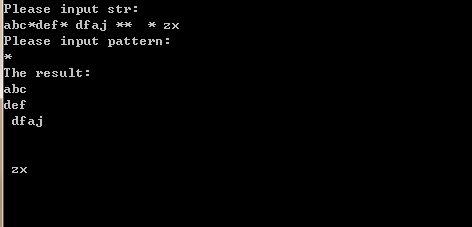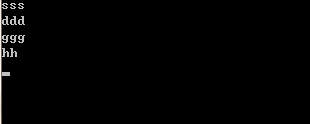按点对字符串进行分隔。题如下:
方法1:
#include<iostream>
#include<string>
#include<string.h>
#include<vector>
#include <boost/algorithm/string/split.hpp>
#include <boost/algorithm/string/classification.hpp>
using namespace std;
int main()
{
string s;
while(cin>>s)
{
int a;
vector<string> vs;
boost::split( vs, s, boost::is_any_of( "." ), boost::token_compress_on );
bool flag=true;
for(int i=0;i<vs.size();i++)
{
int t=atoi(vs[i].c_str()) ;
if(t<0||t>255)
{
cout<<"NO"<<endl;
flag=false;
//return 0;//不能连续输入
}
}
if(flag)
cout<<"YES"<<endl;
}
return 0;
}
方法2:
#include<iostream>
#include<string>
#include<string.h>
using namespace std;
int main()
{
char a[900];
int k=0;
while(cin>>a)
{ bool flag=true;
char* ptr;
ptr = strtok(a, ".");
// while(ptr != NULL)
while(ptr = strtok(NULL, "."))
{
int t=atoi(ptr) ;
if(t<0||t>255)
{
cout<<"NO"<<endl;
flag=false;
//return 0;//不能连续输入
}
// ptr = strtok(NULL, ".");
}
if(flag)
cout<<"YES"<<endl;
}
return 0;
}
题目描述
现在IPV4下用一个32位无符号整数来表示,一般用点分方式来显示,点将IP地址分成4个部分,每个部分为8位,表示成一个无符号整数(因此不需要用正号出现),如10.137.17.1,是我们非常熟悉的IP地址,一个IP地址串中没有空格出现(因为要表示成一个32数字)。
现在需要你用程序来判断IP是否合法。
输入描述:
输入一个ip地址
输出描述:
返回判断的结果YES or NO
输入例子:
10.138.15.1
输出例子:
YES
http://www.jb51.net/article/55954.htm 经典
本文实例汇总了C++常用字符串分割方法,分享给大家供大家参考。具体分析如下:
我们在编程的时候经常会碰到字符串分割的问题,这里总结下,也方便我们以后查询使用。
一、用strtok函数进行字符串分割
原型: char *strtok(char *str, const char *delim);
功能:分解字符串为一组字符串。
参数说明:str为要分解的字符串,delim为分隔符字符串。
返回值:从str开头开始的一个个被分割的串。当没有被分割的串时则返回NULL。
其它:strtok函数线程不安全,可以使用strtok_r替代。
示例:
|
1
2
3
4
5
6
7
8
9
10
11
12
13
14
15
16
17
18
|
//借助strtok实现split
#include <string.h>
#include <stdio.h>
int
main()
{
char
s[] =
"Golden Global View,disk * desk"
;
const
char
*d =
" ,*"
;
char
*p;
p =
strtok
(s,d);
while
(p)
{
printf
(
"%s\n"
,p);
p=
strtok
(NULL,d);
}
return
0;
}
|
运行效果如下图所示:

二、用STL进行字符串的分割
涉及到string类的两个函数find和substr:
1、find函数
原型:size_t find ( const string& str, size_t pos = 0 ) const;
功能:查找子字符串第一次出现的位置。
参数说明:str为子字符串,pos为初始查找位置。
返回值:找到的话返回第一次出现的位置,否则返回string::npos
2、substr函数
原型:string substr ( size_t pos = 0, size_t n = npos ) const;
功能:获得子字符串。
参数说明:pos为起始位置(默认为0),n为结束位置(默认为npos)
返回值:子字符串
实现如下:
|
1
2
3
4
5
6
7
8
9
10
11
12
13
14
15
16
17
18
19
20
|
//字符串分割函数
std::vector<std::string> split(std::string str,std::string pattern)
{
std::string::size_type pos;
std::vector<std::string> result;
str+=pattern;
//扩展字符串以方便操作
int
size=str.size();
for
(
int
i=0; i<size; i++)
{
pos=str.find(pattern,i);
if
(pos<size)
{
std::string s=str.substr(i,pos-i);
result.push_back(s);
i=pos+pattern.size()-1;
}
}
return
result;
}
|
完整代码:
|
1
2
3
4
5
6
7
8
9
10
11
12
13
14
15
16
17
18
19
20
21
22
23
24
25
26
27
28
29
30
31
32
33
34
35
36
37
38
39
40
41
42
43
44
45
46
47
48
49
50
51
|
/*
File : split1.cpp
Author : Mike
E-Mail : Mike_Zhang@live.com
*/
#include <iostream>
#include <string>
#include <vector>
//字符串分割函数
std::vector<std::string> split(std::string str,std::string pattern)
{
std::string::size_type pos;
std::vector<std::string> result;
str+=pattern;
//扩展字符串以方便操作
int
size=str.size();
for
(
int
i=0; i<size; i++)
{
pos=str.find(pattern,i);
if
(pos<size)
{
std::string s=str.substr(i,pos-i);
result.push_back(s);
i=pos+pattern.size()-1;
}
}
return
result;
}
int
main()
{
std::string str;
std::cout<<
"Please input str:"
<<std::endl;
//std::cin>>str;
getline(std::cin,str);
std::string pattern;
std::cout<<
"Please input pattern:"
<<std::endl;
//std::cin>>pattern;
getline(std::cin,pattern);
//用于获取含空格的字符串
std::vector<std::string> result=split(str,pattern);
std::cout<<
"The result:"
<<std::endl;
for
(
int
i=0; i<result.size(); i++)
{
std::cout<<result[i]<<std::endl;
}
std::cin.get();
std::cin.get();
return
0;
}
|
运行效果如下图所示:

三、用Boost进行字符串的分割
用boost库的正则表达式实现字符串分割
实现如下:
|
1
2
3
4
5
6
7
8
9
10
11
12
|
std::vector<std::string> split(std::string str,std::string s)
{
boost::regex reg(s.c_str());
std::vector<std::string> vec;
boost::sregex_token_iterator it(str.begin(),str.end(),reg,-1);
boost::sregex_token_iterator end;
while
(it!=end)
{
vec.push_back(*it++);
}
return
vec;
}
|
完整代码:
|
1
2
3
4
5
6
7
8
9
10
11
12
13
14
15
16
17
18
19
20
21
22
23
24
25
26
27
28
29
30
31
32
33
34
35
36
37
38
39
|
//本程序实现的是利用正则表达式对字符串实现分割
//运行环境 VC6.0 + boost 库
/*
File : split2.cpp
Author : Mike
E-Mail : Mike_Zhang@live.com
*/
#include <iostream>
#include <cassert>
#include <vector>
#include <string>
#include "boost/regex.hpp"
std::vector<std::string> split(std::string str,std::string s)
{
boost::regex reg(s.c_str());
std::vector<std::string> vec;
boost::sregex_token_iterator it(str.begin(),str.end(),reg,-1);
boost::sregex_token_iterator end;
while
(it!=end)
{
vec.push_back(*it++);
}
return
vec;
}
int
main()
{
std::string str,s;
str=
"sss/ddd/ggg/hh"
;
s=
"/"
;
std::vector<std::string> vec=split(str,s);
for
(
int
i=0,size=vec.size();i<size;i++)
{
std::cout<<vec[i]<<std::endl;
}
std::cin.get();
std::cin.get();
return
0;
}
|
运行效果如下图所示:

补充:
最近发现boost里面有自带的split的函数,如果用boost的话,还是直接用split的好,这里就不多说了,代码如下:
|
1
2
3
4
5
6
7
8
9
10
11
12
13
14
15
16
17
|
#include <iostream>
#include <string>
#include <vector>
#include <boost/algorithm/string/classification.hpp>
#include <boost/algorithm/string/split.hpp>
using
namespace
std;
int
main()
{
string s =
"sss/ddd,ggg"
;
vector<string> vStr;
boost::split( vStr, s, boost::is_any_of(
",/"
), boost::token_compress_on );
for
( vector<string>::iterator it = vStr.begin(); it != vStr.end(); ++ it )
cout << *it << endl;
return
0;
}
|





















 1069
1069











 被折叠的 条评论
为什么被折叠?
被折叠的 条评论
为什么被折叠?








